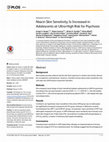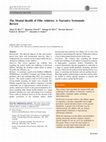Papers by Patrick McGorry

Social Psychiatry and Psychiatric Epidemiology
BackgroundA core component of treatment provided by early intervention for psychosis (EI) service... more BackgroundA core component of treatment provided by early intervention for psychosis (EI) services is ensuring individuals remain successfully engaged with the service. This ensures they can receive the care they may need at this critical early stage of illness. Unfortunately, rates of disengagement are high in individuals with a first episode of psychosis (FEP), representing a major barrier to effective treatment. This study aimed to ascertain the rates and determinants of disengagement and subsequent re-engagement of young people with FEP in a well-established EI service in Melbourne, Australia.MethodThis cohort study involved all young people, aged 15–24, who presented to the Early Psychosis Prevention and Intervention Centre (EPPIC) service with FEP between 1st January 2011 and 1st September 2014. Data were collected retrospectively from clinical files and electronic records. Cox regression analysis was used to identify determinants of disengagement and re-engagement.ResultsA total of 707 young people presented with FEP during the study period, of which complete data were available for 700. Over half of the cohort (56.3%, N = 394) disengaged at least once during their treatment period, however, the majority of these individuals (85.5%, N = 337) subsequently re-engaged following the initial episode of disengagement. Of those who disengaged from the service, 54 never re-engaged, representing 7.6% of the total cohort. Not being in employment, education or training, not having a family history of psychosis in second degree relatives and using cannabis were found to be significant predictors of disengagement. No significant predictors of re-engagement were identified.ConclusionIn this study, the rate of disengagement in young people with first-episode psychosis was higher than found previously. Encouragingly, rates of re-engagement were also high. The concept of disengagement from services might be more complex than previously thought with individuals disengaging and re-engaging a number of times during their episode of care. What prompts individuals to re-engage with services needs to be better understood.

Translational psychiatry, Jan 6, 2018
Mood disturbances seen in first-episode mania (FEM) are linked to disturbed functional connectivi... more Mood disturbances seen in first-episode mania (FEM) are linked to disturbed functional connectivity of the striatum. Lithium and quetiapine are effective treatments for mania but their neurobiological effects remain largely unknown. We conducted a single-blinded randomized controlled maintenance trial in 61 FEM patients and 30 healthy controls. Patients were stabilized for a minimum of 2 weeks on lithium plus quetiapine then randomly assigned to either lithium (serum level 0.6 mmol/L) or quetiapine (dosed up to 800 mg/day) treatment for 12 months. Resting-state fMRI was acquired at baseline, 3 months (patient only) and 12 months. The effects of treatment group, time and their interaction, on striatal functional connectivity were assessed using voxel-wise general linear modelling. At baseline, FEM patients showed reduced connectivity in the dorsal (p = 0.05) and caudal (p = 0.008) cortico-striatal systems when compared to healthy controls at baseline. FEM patients also showed increas...
World Psychiatry
If citing, it is advised that you check and use the publisher's definitive version for pagination... more If citing, it is advised that you check and use the publisher's definitive version for pagination, volume/issue, and date of publication details. And where the final published version is provided on the Research Portal, if citing you are again advised to check the publisher's website for any subsequent corrections.

World Psychiatry
Illness staging is widely utilized in several medical disciplines to help predict course or progn... more Illness staging is widely utilized in several medical disciplines to help predict course or prognosis, and optimize treatment. Staging models in psychiatry in general, and bipolar disorder in particular, depend on the premise that psychopathology moves along a predictable path: an at-risk or latency stage, a prodrome progressing to a first clinical threshold episode, and one or more recurrences with the potential to revert or progress to late or end-stage manifestations. The utility and validity of a staging model for bipolar disorder depend on its linking to clinical outcome, treatment response and neurobiological measures. These include progressive biochemical, neuroimaging and cognitive changes, and potentially stage-specific differences in response to pharmacological and psychosocial treatments. Mechanistically, staging models imply the presence of an active disease process that, if not remediated, can lead to neuroprogression, a more malignant disease course and functional deterioration. Biological elements thought to be operative in bipolar disorder include a genetic diathesis, physical and psychic trauma, epigenetic changes, altered neurogenesis and apoptosis, mitochondrial dysfunction, inflammation, and oxidative stress. Many available agents, such as lithium, have effects on these targets. Staging models also suggest the utility of stage-specific treatment approaches that may not only target symptom reduction, but also impede illness neuroprogression. These treatment approaches range from prevention for at-risk individuals, to early intervention strategies for prodromal and newly diagnosed individuals, complex combination therapy for rapidly recurrent illness, and palliative-type approaches for those at chronic, late stages of illness. There is hope that prompt initiation of potentially disease modifying therapies may preclude or attenuate the cognitive and structural changes seen in the later stages of bipolar disorder. The aims of this paper are to: a) explore the current level of evidence supporting the descriptive staging of the syndromal pattern of bipolar disorder; b) describe preliminary attempts at validation; c) make recommendations for the direction of further studies; and d) provide a distillation of the potential clinical implications of staging in bipolar disorder within a broader transdiagnostic framework.

Early intervention in psychiatry, Jan 18, 2017
Previous research indicates that preventive intervention is likely to benefit patients "at r... more Previous research indicates that preventive intervention is likely to benefit patients "at risk" of psychosis, in terms of functional improvement, symptom reduction and delay or prevention of onset of threshold psychotic disorder. The primary aim of the current study is to test outcomes of ultra high risk (UHR) patients, primarily functional outcome, in response to a sequential intervention strategy consisting of support and problem solving (SPS), cognitive-behavioural case management and antidepressant medication. A secondary aim is to test biological and psychological variables that moderate and mediate response to this sequential treatment strategy. This is a sequential multiple assignment randomised trial (SMART) consisting of three steps: Step 1: SPS (1.5 months); Step 2: SPS vs Cognitive Behavioural Case Management (4.5 months); Step 3: Cognitive Behavioural Case Management + Antidepressant Medication vs Cognitive Behavioural Case Management + Placebo (6 months). The...

Early intervention in psychiatry, Apr 30, 2016
Early intervention and prevention of serious mental disorders such as bipolar disorder has the pr... more Early intervention and prevention of serious mental disorders such as bipolar disorder has the promise of decreasing the burden associated with these disorders. With increasing early and preventive intervention efforts among cohorts such as those with a familial risk for bipolar disorder, there is a need to examine the associated ethical concerns. The aim of this review was to examine the ethical issues underpinning the clinical research on pre-onset identification and preventive interventions for bipolar disorder. We undertook a PubMed search updated to November 2014 incorporating search terms such as bipolar, mania, hypomania, ethic*(truncated), early intervention, prevention, genetic and family. Fifty-six articles that were identified by this method as well as other relevant articles were examined within a framework of ethical principles including beneficence, non-maleficence, respect for autonomy and justice. The primary risks associated with research and clinical interventions ...

Schizophrenia Bulletin, 2016
Most individuals at ultra-high risk (UHR) for psychosis do not transition to frank illness. Never... more Most individuals at ultra-high risk (UHR) for psychosis do not transition to frank illness. Nevertheless, many have poor clinical outcomes and impaired psychosocial functioning. This study used voxel-based morphometry to investigate if baseline grey and white matter brain densities at identification as UHR were associated with functional outcome at medium-to long-term follow-up. Participants were help-seeking UHR individuals (n=109, 54M:55F) who underwent magnetic resonance imaging at baseline; functional outcome was assessed an average of 9.2 years later. Primary analysis showed that lower baseline grey matter density, but not white matter density, in bilateral frontal and limbic areas, and left cerebellar declive were associated with poorer functional outcome (SOFAS). These findings were independent of transition to psychosis or persistence of the at-risk mental state. Similar regions were significantly associated with lower self-reported levels of social functioning and increased negative symptoms at follow-up. Exploratory analyses showed that lower baseline grey matter densities in middle and inferior frontal gyri were significantly associated with decline in GAF score over follow-up. There was no association between baseline grey matter density and IQ or positive symptoms at follow-up. The current findings provide novel evidence that those with the poorest functional outcomes have the lowest grey matter densities at identification as UHR, regardless of transition status or persistence of the at-risk mental state. Replication and validation of these findings may allow for early identification of poor functional outcome and targeted interventions.

PLOS ONE, 2016
Background Most studies provide evidence that the skin flush response to nicotinic acid (niacin) ... more Background Most studies provide evidence that the skin flush response to nicotinic acid (niacin) stimulation is impaired in schizophrenia. However, only little is known about niacin sensitivity in the ultra-high risk (UHR) phase of psychotic disorders. Methods We compared visual ratings of niacin sensitivity between adolescents at UHR for psychosis according to the one year transition outcome (UHR-T n = 11; UHR-NT n = 55) with healthy controls (HC n = 25) and first episode schizophrenia patients (FEP n = 25) treated with atypical antipsychotics. Results Contrary to our hypothesis niacin sensitivity of the entire UHR group was not attenuated, but significantly increased compared to the HC group, whereas no difference could be found between the UHR-T and UHR-NT groups. As expected, niacin sensitivity of FEP was attenuated compared to HC group. In UHR individuals niacin sensitivity was inversely correlated with omega-6 and-9 fatty acids (FA), but positively correlated with phospholipase A 2 (inPLA 2) activity, a marker of membrane lipid repair/remodelling.

Sports medicine (Auckland, N.Z.), Jan 20, 2016
The physical impacts of elite sport participation have been well documented; however, there is co... more The physical impacts of elite sport participation have been well documented; however, there is comparatively less research on the mental health and psychological wellbeing of elite athletes. This review appraises the evidence base regarding the mental health and wellbeing of elite-level athletes, including the incidence and/or nature of mental ill-health and substance use. A systematic search of the PubMed, EMBASE, SPORTDiscus, PsycINFO, Cochrane and Google Scholar databases, up to and including May 2015, was conducted. The search yielded a total of 2279 records. Following double screening, 60 studies were included. The findings suggested that elite athletes experience a broadly comparable risk of high-prevalence mental disorders (i.e. anxiety, depression) relative to the general population. Evidence regarding other mental health domains (i.e. eating disorders, substance use, stress and coping) is less consistent. These results are prefaced, however, by the outcome of the quality as...
Schizophrenia Research, 2003
Schizophrenia Research, 2003
patient groups show perceptual matching deficits contributing to WM deficits observed in schizoph... more patient groups show perceptual matching deficits contributing to WM deficits observed in schizophrenia. These deficits may result from a deficit in encoding. FE patients are further impaired in delay dependent WM tasks, which may result from a deficit in maintenance or recognition processes.
Schizophrenia Research, 2015

The Journal of nervous and mental disease, 2015
Early intervention for potentially serious disorder is a fundamental feature of healthcare across... more Early intervention for potentially serious disorder is a fundamental feature of healthcare across the spectrum of physical illness. It has been a major factor in the reductions in morbidity and mortality that have been achieved in some of the non-communicable diseases, notably cancer and cardiovascular disease. Over the past two decades, an international collaborative effort has been mounted to build the evidence and the capacity for early intervention in the psychotic disorders, notably schizophrenia, where for so long deep pessimism had reigned. The origins and rapid development of early intervention in psychosis are described from a personal and Australian perspective. This uniquely evidence-informed, evidence-building and cost-effective reform provides a blueprint and launch pad to radically change the wider landscape of mental health care and dissolve many of the barriers that have constrained progress for so long.
Schizophrenia Research, 2010

Journal of Affective Disorders, 2015
Background: Identification of risk factors within precursor syndromes, such as depression, anxiet... more Background: Identification of risk factors within precursor syndromes, such as depression, anxiety or substance use disorders (SUD), might help to pinpoint high-risk stages where preventive interventions for Bipolar Disorder (BD) could be evaluated. Methods: We examined baseline demographic, clinical, quality of life, and temperament measures along with risk clusters among 52 young people seeking help for depression, anxiety or SUDs without psychosis or BD. The risk clusters included Bipolar At-Risk (BAR) and the Bipolarity Index as measures of bipolarity and the Ultra-High Risk assessment for psychosis. The participants were followed up for 12 months to identify conversion to BD. Those who converted and did not convert to BD were compared using Chi-Square and Mann Whitney U tests. Results: The sample was predominantly female (85%) and a majority had prior treatment (64%). Four participants converted to BD over the 1-year follow up period. Having an alcohol use disorder at baseline (75% vs 8%, Ȥ 2 =14.1, p<0.001) or a family history of SUD (67% vs 12.5%, Ȥ 2 =6.0, p=0.01) were associated with development of BD. The sub-threshold mania subgroup of BAR criteria was also associated with 12-month BD outcomes. The severity of depressive symptoms and cannabis use had high effects sizes of association with BD outcomes, without statistical significance. Conclusions and Limitations: The small number of conversions limited the power of the study to identify associations with risk factors that have previously been reported to predict BD. However, subthreshold affective symptoms and SUDs might predict the onset of BD among help-seeking young people with highprevalence disorders.
Schizophrenia Research, 2006
World psychiatry : official journal of the World Psychiatric Association (WPA), 2002
Australian family physician, 2002
Asylum seekers may be front page news but the abuse they continue to suffer remains largely hidde... more Asylum seekers may be front page news but the abuse they continue to suffer remains largely hidden. This is particularly evident in the case of detainees held under maximum security conditions in harsh and remote parts of Australia. What are the health consequences of Australia?s refugee policy and what are the implications for doctors and other health professionals? (non-author abstract)
Schizophrenia Research, 1998










Uploads
Papers by Patrick McGorry